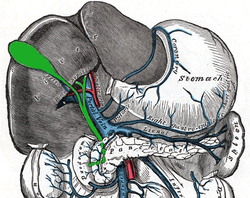
Summary
The cystohepatic triangle (or hepatobiliary triangle or Calot's triangle) is an anatomic space bordered by the cystic duct inferiorly, the common hepatic duct medially, and the inferior surface of the liver superiorly.
| Cystohepatic triangle | |
|---|---|
 The cystic artery branches from the right hepatic artery. | |
 Relationship to other vessels | |
| Details | |
| Identifiers | |
| Latin | trigonum cystohepaticum |
| TA98 | A10.1.02.428 |
| TA2 | 3756 |
| FMA | 24230 |
| Anatomical terminology [edit on Wikidata] | |

The cystic artery lies within the hepatobiliary triangle. The triangle is used to locate the cystic artery during a laparoscopic cholecystectomy.
Structure edit
The hepatobiliary triangle is the area bounded by the:
- cystic duct inferiorly[1][2]
- common hepatic duct medially[1][2]
- inferior margin of the liver superiorly[1][2]
It is covered in peritoneum both anteriorly and posteriorly.[2]
Contents edit
The triangle contains: adipose and connective tissue, lymphatic vessels and the cystic lymph node, autonomic nerves, (usually) cystic artery, and (sometimes) an accessory cystic duct.[3] The right hepatic artery may also pass through the hepatobiliary triangle.[2]
Clinical significance edit
The anatomy and variant anatomy of this region is important during gallbladder removal to prevent iatrogenic injury to the common hepatic duct, bile duct, or right hepatic artery.[3]
The cystic artery lies within the hepatobiliary triangle, which is used to locate it during a laparoscopic cholecystectomy.[4][5] It may also contain an accessory right hepatic artery or an anomalous sectoral bile ducts. As a result, dissection in the triangle of Calot is ill-advised until the lateral-most structures have been cleared and identification of the cystic duct is definitive. According to SESAP 12 (produced and distributed by the American College of Surgeons) dissection in the triangle of Calot is the most common cause of common bile duct injuries.
History edit
Another name used to refer to the hepatobiliary triangle is Calot's triangle, after Jean-François Calot.[6][7] Calot's original description of the triangle in 1891 included the cystic duct, the common hepatic duct, and the cystic artery (not the inferior border of the liver as is commonly believed).[4]
References edit
- ^ a b c Schwartz's Manual of Surgery BRUNICARDI C.F 10th edition
- ^ a b c d e Connor, Saxon J.; Perry, William; Nathanson, Leslie; Hugh, Thomas B.; Hugh, Thomas J. (May 2014). "Using a standardized method for laparoscopic cholecystectomy to create a concept operation-specific checklist". HPB. 16 (5): 422–429. doi:10.1111/hpb.12161. ISSN 1365-182X. PMC 4008160. PMID 23961737.
- ^ a b Standring, Susan (2020). Gray's Anatomy: The Anatomical Basis of Clinical Practice (42th ed.). New York. p. 1219. ISBN 978-0-7020-7707-4. OCLC 1201341621.
{{cite book}}: CS1 maint: location missing publisher (link) - ^ a b Haubrich, William (November 2002). "Calot of the triangle of Calot". Gastroenterology. 123 (5): 1440. doi:10.1053/gast.2002.1231440. PMID 12404217.
- ^ Orozco, Hector; Mercado, Miguel Angel; Takahashi, Takeshi; Hernández-Ortiz, Jorge; Capellán^S, Juan Félix; Garcia-Tsao, Guadalupe (June 1992). "Elective treatment of bleeding varices with the Sugiura operation over 10 years". The American Journal of Surgery. 163 (6): 585–589. doi:10.1016/0002-9610(92)90562-6. ISSN 0002-9610. PMID 1595838.
- ^ synd/4023 at Who Named It?
- ^ J. F. Calot. De la cholécystectomie. Doctoral thesis, Paris, 1891.
6. Bailey & Love's Short Practice of Surgery 26th edition (see page 1098).


